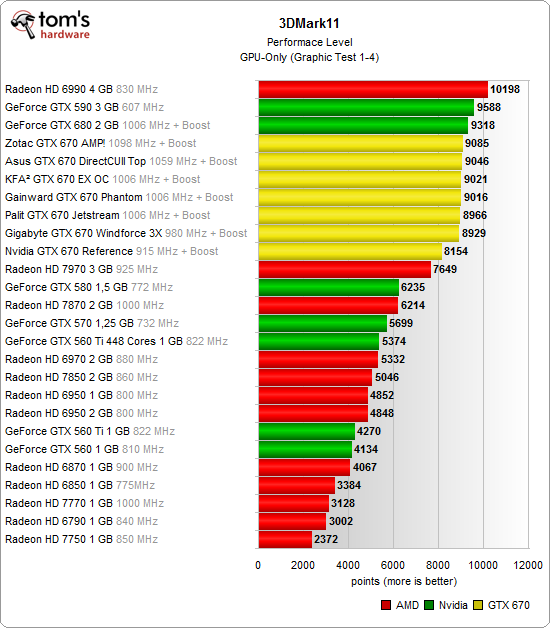Seven GeForce GTX 670 Cards, Benchmarked And Reviewed
We have seven GeForce GTX 670 cards. Which is fastest? Which is quietest? Each one swaggers onto the scene ready to prove its worth to your wallet. We emphasize thermals, acoustics, and design in this many-way shoot-out based on Nvidia's capable GK104.
Benchmark Results: 3DMark 11 And Crysis 2 (DX 11)
A Quick Word About Drivers
When this story was originally published in Germany, the newest beta driver version was 301.34, originally intended to add support for GeForce GTX 690. It improves 3DMark results by a few percent, but it wouldn't work with all of our samples. We traced this issue to the BIOS version of some of our test cards, and finally tweaked the .INF file of build 301.33 to get it working with all cards. In that way, the GeForce-based results are all comparable.
Unfortunately, this story went live in Europe long before AMD's beta Catalyst 12.7 build was previewed, and even beta 12.6 was not yet available. As of this writing, the Catalyst 12.7 beta is still not downloadable from AMD's site, so 12.6 is the most current build you can get. Once 12.7 is posted, results for the Radeon HD 7970 should improve, though we saw in AMD Radeon HD 7970 GHz Edition Review: Give Me Back That Crown! that Nvidia's GeForce GTX 670 is faster in 3DMark. Though the Crysis 2 settings used in that more recent story favored Nvidia's card, AMD's Radeon HD 7970 actually wins here.
3DMark 11
We ran this benchmark at all three quality presets, and the results demonstrate that performance scales well with clock rate. Although most enthusiasts aren't going to buy a high-end card to play at low-end settings, this metric helps amplify minor differences between the three 1006 MHz samples.
Our tests show that all factory-overclocked cards perform similarly, and they also help illustrate that if a game is unplayable on a board with a 980 MHz core, spending extra on a solution with a 1098 MHz core won't help make it smoother all of the sudden.
Factory-overclocked cards do perform better than reference models at extreme quality settings, but the differences are not earth-shattering.
Get Tom's Hardware's best news and in-depth reviews, straight to your inbox.
Crysis 2: DirectX 11
We intentionally selected only one gaming benchmark; adding more wouldn't change the story that plays out between these modified GeForce GTX 670 cards.
It's interesting that the GeForce GTX 680, which is faster in synthetic benchmarks, is equaled or even surpassed by equally-clocked or slightly higher-clocked GTX 670s. This isn't caused by a processor limitation, since we can try different GPU clocks and see immediate frame rate scaling. Rather, we suspect a driver problem. There doesn't seem to be any other explanation.
Current page: Benchmark Results: 3DMark 11 And Crysis 2 (DX 11)
Prev Page How We Test Next Page Sound Level And Temperature: Stock Settings
Igor Wallossek wrote a wide variety of hardware articles for Tom's Hardware, with a strong focus on technical analysis and in-depth reviews. His contributions have spanned a broad spectrum of PC components, including GPUs, CPUs, workstations, and PC builds. His insightful articles provide readers with detailed knowledge to make informed decisions in the ever-evolving tech landscape
-
user 18 On the Gigabyte card's page:Reply
During the course of our testing, we effortlessly set this card to run at 1059 MHz, so we're not sure why Gigabyte held back so much. During testing, we overclocked this card to 1059 MHz quite easily, so we are somewhat surprised by the conservative factory overclock.
This seems to be saying the same thing twice. Error, or am I missing something? -
FormatC Reply
The roundup was published in German on May 22, 2012:10445301 said:Where is the msi gtx 670 power edition?
http://www.tomshardware.de/Nvidia-Geforce-GTX-670-Roundup,testberichte-241027.html
Sorry, but at this time (and 4 weeks later too) MSI was unable to deliver one of this cards. When MSI starts so late with this cards, then this is not our fault. ;)
-
user 18 Also, the second chart on the 'Sound Level and Temperature: Overclocked' page is missing the 'Mhz' label on the speed for the Palit card. It should read '1059 Mhz', while it reads only '1059'.Reply -
LonelyMan I'd like to see one for the 680s too, in which the 680 classified and lightning will be present, including others. :DReply



